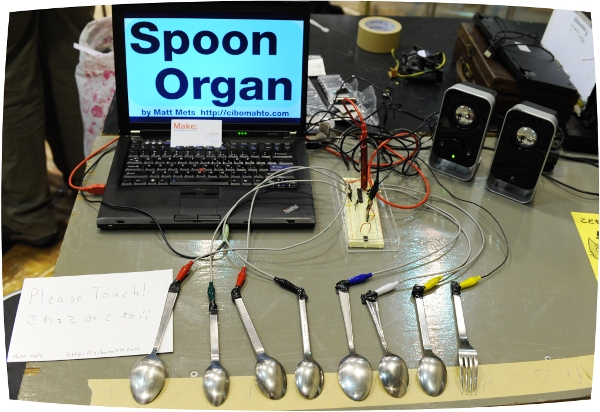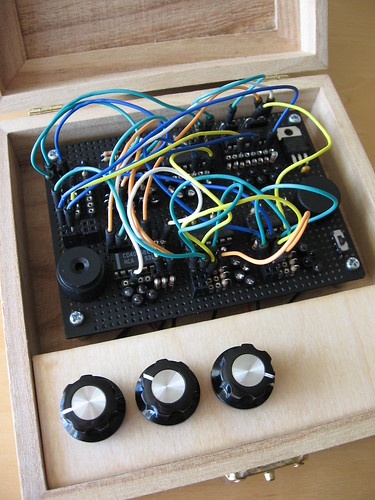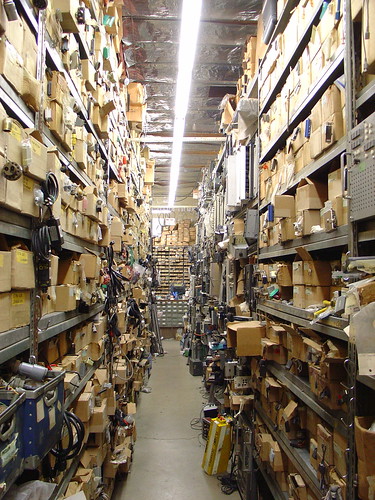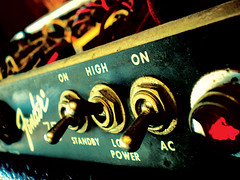Tuesday, November 30, 2010
Sunday, November 28, 2010
Tube Boost Looper
This is for a project that I am currently working on right now. Its a dual tube boost with a FX loop. Its based on the Bass Paralooper and the Valve Caster . I have two identical boosts, modified with larger input capacitors; Currently I am just using the trim pot to set the gain. More to come later!
Update:
So I drilled out the case yesterday but screwed up on the placement of the jacks for the loop send and return, they are in the way for the tube sockets. I think I'll take a brass strip and use that to cover up the existing hole and mount the jacks to that. Other than that screw up this is one of my most accurate drillings for an fx box.

Labels:
DIY,
Personal Build
Friday, November 26, 2010
Got a Few Old Unused Records Lying Around?
Matt Glassmeyer of Nashville, Tenn., built this roof out of 350 records. The roof is on the north side of the house and gets no direct sunlight, and shows no sign of warping.
[via MAKE via Core77 via Treehugger ]


[via MAKE via Core77 via Treehugger ]



Tuesday, November 23, 2010
Mammoth 2
This is yet another attempt at the Mammoth Fuzz I could not get the other to sound like I wanted it to so this one will work hopefully. Same layout as before from Tag Board Effects Used a Dermal tool to grind the Copper away leaving nice pads to solder onto. Build time was about an hour and half.

Please leave a comment telling me what you think.

Please leave a comment telling me what you think.
Labels:
Clone,
DIY,
Effects,
Mammoth,
Personal Build
Monday, November 22, 2010
Spoon Organ
This is from: C i b o M a h t o . c o m

"Spoon Organ is an instrument that I created to show at the Make Tokyo Meeting 06 this past weekend. The user can play musical tunes simply by touching a row of spoons sitting on a table, with a fork added in for good measure. A microcontroller is used to detect changes in capacitance caused by a finger pressing against the metal, which are then sent to a computer using the MIDI protocol."

"Spoon Organ is an instrument that I created to show at the Make Tokyo Meeting 06 this past weekend. The user can play musical tunes simply by touching a row of spoons sitting on a table, with a fork added in for good measure. A microcontroller is used to detect changes in capacitance caused by a finger pressing against the metal, which are then sent to a computer using the MIDI protocol."
Friday, November 19, 2010
Mini Lunetta Patched Close up
Check out the Electro-music forums for more project info and users' builds.
This one is built bysndbyte's


Wednesday, November 17, 2010
Electronic Music Studios
This excellent doco covering the origins and life of Electronic Music Studios. A company formed by avant-garde musicians & engineers who all shared a passion for electronic sound. Their collaborative efforts brought about the first digital electronic music sequencer, utilizing a relatively massive amount of computing power for the 1950s.
More info
More info
Monday, November 15, 2010
TorrentMeter - A Steampunk Bandwidth Meter
This is from Skytee
Its and analog gauge that displays the bandwidth of torrents being downloaded.
I got inspired by reading Tom Igoe's article in Make Magazine issue 11, about an antique gauge displaying air quality data from the web. It hit a nerve: friends and I had once built asteam powered teletype. Since we've got fiber optical intertubes at home, I wanted a big brass gauge telling me how big my pipe was. And that's the idea of my TorrentMeter.

Video of it in action.
Full Article
Its and analog gauge that displays the bandwidth of torrents being downloaded.
I got inspired by reading Tom Igoe's article in Make Magazine issue 11, about an antique gauge displaying air quality data from the web. It hit a nerve: friends and I had once built asteam powered teletype. Since we've got fiber optical intertubes at home, I wanted a big brass gauge telling me how big my pipe was. And that's the idea of my TorrentMeter.

Video of it in action.
Full Article
Sunday, November 14, 2010
010
This is a Fender 75 that my friend Rusty asked me to take a look at; the lead channel of it was not working on it. While working on it I took the opportunity to take some pictures of it, and since photo-shoped. Good news its working now but the bad news is that I don't know what I did in order to get it working again so if it fails again I am back at square one. 010 refers to the binary positions of the switches, great part is I did not plan that when I took the picture.
DIY RAM Memory- Register Style
This is from Instructables.com. Its an amazing hand built three bit memory. 

DIY RAM Memory- Register Style
**UPDATE** I also made a CMOS version here: http://www.instructables.com/id/DIY-CMOS-RAM-Memory/
If you have ever looked at a microcontroller's datasheet, you have probably seen something about registers. Registers are little one or two byte memory storage units in microcontrollers. The register in this instructable can hold 3 bits of data (b/c I ran out of room on my breadboards) using transistors. I did this to prove that I can, however, its not practical as an 8 bit register requires 64 transistors, about 64 resistors and lots of space.
The register is a neat device. It can recieve data when the enable input is, in my circuit, low and it can then latch and save the data even it the data line is changing. My circuit is not the conventional D-type latch because it used more transistors than I had.
If you have ever looked at a microcontroller's datasheet, you have probably seen something about registers. Registers are little one or two byte memory storage units in microcontrollers. The register in this instructable can hold 3 bits of data (b/c I ran out of room on my breadboards) using transistors. I did this to prove that I can, however, its not practical as an 8 bit register requires 64 transistors, about 64 resistors and lots of space.
The register is a neat device. It can recieve data when the enable input is, in my circuit, low and it can then latch and save the data even it the data line is changing. My circuit is not the conventional D-type latch because it used more transistors than I had.
Swishercutter left a great comment:
Labels:
DIY
Wednesday, November 10, 2010
Meet Meeblip
Via Make

Meet Meeblip, The Open Source, Hackable Digital Hardware Synth... Peter writes -
Making music, making blips and bleeps, turning knobs, plugging in keyboards, and having the freedom to modify your gear – these are good things. And that’s why I’m so excited that today is the day the MeeBlip launches.
It’s been several years in development, but now it’s finally here. It’s a hardware box that makes noises – virtual analog synth noises, chip-sounding noises, good noises, bad noises, noises you can make into music. It’s got physical knobs and switches on it, plus a MIDI DIN in port so you can connect that keytar you bought on eBay. It’s also a digital synth you can build, modify, and hack, down to the way every knob is mapped and every sound is blipped.
The MeeBlip is the creation of James Grahame, of Retro Thing and Reflex Audio fame. But we’re serious about the Create Digital Music name going on there, too. We’ll be documenting and helping develop this instrument for some time to come, and we’ve begun building a site and community for the instrument so you have a place to meet other people using it.
The MeeBlip, from code to schematics, is open source hardware. You can hack it, read through the code, make your own and sell it. At the same time, just because it’s “open source” and “hackable” doesn’t mean the MeeBlip is just for hackers. On the contrary – we wanted a synth anyone could play. With the Quick Build Kit, you can assemble the MeeBlip without a soldering iron or, really, much skill, in a matter of minutes. Plug it in, turn some knobs, and you can make some sounds. And if later you decide you want to go deeper or even change the way the instrument works, you can do that, too.
Check out their web site here

Meet Meeblip, The Open Source, Hackable Digital Hardware Synth... Peter writes -
Making music, making blips and bleeps, turning knobs, plugging in keyboards, and having the freedom to modify your gear – these are good things. And that’s why I’m so excited that today is the day the MeeBlip launches.
It’s been several years in development, but now it’s finally here. It’s a hardware box that makes noises – virtual analog synth noises, chip-sounding noises, good noises, bad noises, noises you can make into music. It’s got physical knobs and switches on it, plus a MIDI DIN in port so you can connect that keytar you bought on eBay. It’s also a digital synth you can build, modify, and hack, down to the way every knob is mapped and every sound is blipped.
The MeeBlip is the creation of James Grahame, of Retro Thing and Reflex Audio fame. But we’re serious about the Create Digital Music name going on there, too. We’ll be documenting and helping develop this instrument for some time to come, and we’ve begun building a site and community for the instrument so you have a place to meet other people using it.
The MeeBlip, from code to schematics, is open source hardware. You can hack it, read through the code, make your own and sell it. At the same time, just because it’s “open source” and “hackable” doesn’t mean the MeeBlip is just for hackers. On the contrary – we wanted a synth anyone could play. With the Quick Build Kit, you can assemble the MeeBlip without a soldering iron or, really, much skill, in a matter of minutes. Plug it in, turn some knobs, and you can make some sounds. And if later you decide you want to go deeper or even change the way the instrument works, you can do that, too.
Check out their web site here
Labels:
Make
1,003
Just broke 1000 page views thanks to every one that has been stoping by!
Labels:
General
Sunday, November 7, 2010
Benjolin Light Synth
This was made by Casper Electronics
"The sound in this video is all made using one my custom built synth that
you can read about it here.
The synth is made up of two complex analog oscillator/modulator/filter circuits,
a light control circuit and a modified BOSS RSD 10 sample/echo module.
I've started playing with a cool feature of the RSD 10 which is that it can
use external oscillators to control the playback rate of the echo and an
external clock to trigger the echo repeats. I'm using a sequenced oscillator
to melodically modulate the pitch of the echo of the other oscillators and
I'm using the sequence clock to trigger the echo. its a cool sounding
effect that gives a relatively normal sequence a bunch of cool quirks to
play with."
I want to make cool rhythmic like this, some day soon it will happen!
Apex Electronics
I got the chance to Apex Electronics today, I was stupid and forgot my camera at home. So, here is two images taken by Mighty Ohm. Going to build some cool tube boost with NOS tube sockets I got.


Flickr


Flickr
Friday, November 5, 2010
Turbo Encabulator
six hydrocoptic marzel vains dude I need one of these
Thursday, November 4, 2010
Make a Point Contact Transistor at home
Really great video from Jeri Ellsworth
Live Rig / Looping
He's doing some really cool stuff live with vey few sources really is quite amazing.
Tuesday, November 2, 2010
Circuit Skills: Perfboard Prototyping, sponsored by Jameco Electronics
This is from Collin Cunningham he has some really cool stuff on his page at Make.
When you think "DIY electronics," one of the first images that likely comes to mind is of parts and wire soldered to a standard piece of perforated circuit board -- and that makes sense. Perfboard is widely used because it's so versatile. Essentially, it's just a grid of potential solder-point connections. You can trim it down to just the size you need, or leave extra space for future enhancements, or revisions, if need be.
Subscribe to:
Posts (Atom)









Whenever I see people build large scale versions of commonly available circuits I always think of my electronics instructor...he wanted to build a "Macroprocessor" which would be built from tubes and relays (he is an ex radar tech) as he put it "...it would be as big as a building, would put off a ton of heat as well as making the most wonderful clicking sound as it ran...".
Lets keep going on these types of Instructables...if we forget how these circuits are designed internally we become not only dependent on the circuit always being there but we also risk losing the spark of ingenuity which led to the design in the first place...you can only go further if you know how we got here.
Maybe we can start a "macroelectronics" tag just for things like this.